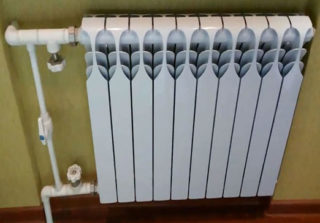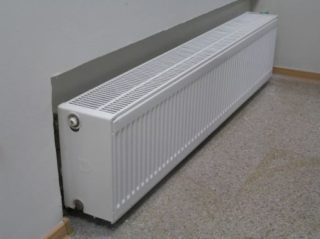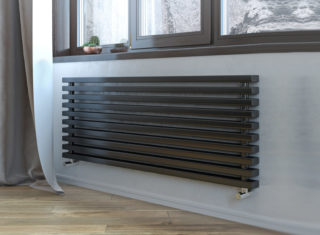If the battery becomes unusable, it will be impossible to survive the winter in a house or apartment. To replace the unit before the onset of cold weather, you need to know what radiators are. Only by understanding the features of different types of heating batteries, you can choose a good option.
Material classification
Most radiators are made of metals. There are plastic varieties that are cheaper. They are lightweight, wear resistant, easy to install. But the temperature of the coolant in the pipes should not be more than 80 degrees, otherwise the system may be damaged. If in doubt, it is better to choose more durable designs.
Cast iron appliances
The main minus of the old-fashioned, but strong cast-iron radiators is the unattractive appearance and weight - up to 9 kg for each section. The disadvantages include the large size, the complexity of integration into the interior of a modern apartment. Of course, a bulky battery can be hidden behind a special screen. But because of this, the time during which the room warms up will increase. But the advantages of cast-iron units are:
- high rate of corrosion resistance;
- Duration of operation - more than half a century;
- budget price.
Devices withstand pressure from 9 to 12 atmospheres, cool for a long time and connect to systems in which not very clean coolant circulates.
Aluminum devices
In their manufacture take lightweight and extremely durable aluminum. In the manufacturing process, the high-pressure casting method is used, due to which the products become:
- reliable;
- resistant to corrosion and pressure;
- easy to connect;
- attractive in appearance.
Also, such products have high heat transfer and a long operating period. Leaks are a rare phenomenon, since all joints are tight enough.
Aluminum batteries can not withstand aggressive heat transfer fluids and water hammer, so they are best installed in private households - they will not withstand high-rise buildings for a long time.
Steel radiators
These are devices that combine the functions of a radiator and convector. Such devices can withstand temperatures up to 120 degrees and pressure up to 10 atmospheres. They heat up almost instantly, but also cooling during shutdown occurs rather quickly.
The main disadvantage is an increased tendency to pollution, which level mud filters.
They are also characterized by a high susceptibility to water hammer in places where there are welds. The device may burst or become deformed during pressure testing, and therefore it is undesirable to install them in houses of more than 5 floors.
Bimetal structures
These are the latest generation heating batteries. They have a steel core and an outer aluminum shell. Due to their high strength, anti-corrosion properties and ability to hold water shocks, they can be installed in multi-storey buildings. Monolithic models are especially good at holding pressure. They are not afraid of blows up to 100 atmospheres. Heat dissipation is also at altitude. The appearance is attractive, and the installation is simple. Weight no more than 2 kg.
The only drawback is the high cost. Bimetallic batteries are several times more expensive than those made of steel or aluminum.
There are pseudo-bimetallic options. So-called devices in which steel reinforcements are only in vertical channels.Their cost is less than the previous ones, more heat transfer, but they are less resistant to corrosion due to the contact of the coolant with aluminum.
Copper batteries
Heating devices of this type have maximum resistance to aggressive environments among all analogues. They hardly wear out, they hold great pressure and water hammer perfectly, they are not afraid of rust. But they also have a drawback - high cost.
A similar type of heating battery is used in central and autonomous systems, in which both water and antifreeze transfer heat.
Copper radiators level the resistance of the coolant. In addition, they have maximum heat dissipation and they increase the efficiency of the heating device.
Design differences
Classification of heating batteries by design characteristics:
- Sectional. Assembled from the same sections with channels for the coolant inside. They have increased heat dissipation, efficiency. It is possible to install a thermostat. However, joints between sections may begin to leak. Also minus the sectional type of heating radiators is the tendency to rapid pollution and blockages.
- Panel. They are two sheets of metal coated with anticorrosive protection and welded to each other. The coolant moves in the vertical channels, and ribs are installed on the back side, increasing the area of the heated surface. Similar devices are lightweight, cheap and compact. But they are afraid of increasing pressure and water hammer, and they need a clean coolant.
- Tubular. Outwardly, they look like two collectors, top and bottom, between which vertical tubes are inserted. It is well warmed, resistant to high blood pressure. The rounded edges and the shape of the tubes prevent dust and dirt from accumulating on the surface. Strong welded joints eliminate leaks. But they are afraid of rust and expensive.
There are also plate types of heating radiators. They are made in the form of a bent water pipe with steel plates mounted on it to enhance air convection. The devices are simple in design and inexpensive. But at the same time they warm the room unevenly and collect dust well.
Forms of radiators
Depending on the configuration, vertical and horizontal types of batteries are distinguished. The latter more evenly distribute heat throughout the apartment.
If the room is cramped, you should prefer a flat model. They consume a small amount of water, which makes it easy to adjust via thermostats. Such devices do not require special care; they look attractive in appearance. Among the minuses - the impossibility of installation in rooms with high humidity, as well as a high price.
Flat and vertical installations must be equipped with air vents, because in this position a difference in internal pressure is formed.
Manufacturers offer not only wall-mounted, but also floor heating devices. They are a heat exchanger with a coolant moving in it, which is surrounded by aluminum or steel plates and is closed externally with a metal crate, a protective casing. They are placed in rooms with the impossibility of installing wall-mounted radiators due to weight or because of panoramic windows. But such devices are more expensive and more difficult to install.
There are autonomous models of radiators that are independent of the heating system. They can be used as additional ones. They need electricity to work. They are oil and quartz, it all depends on the type of heating element. The first is cheaper and more mobile, the second is more productive.
Criterias of choice
When selecting a battery, the following characteristics should be considered:
- The operating pressure declared by the manufacturer must exceed the pressure in the heating system.
- The radiator must be resistant to water hammer.
- The inner surface of the walls of the heat exchanger must be with a special anti-corrosion and anti-mud coating.
Choosing a device is with the greatest heat dissipation and maximum service life.
In addition to these criteria, the appearance of the radiator, its cost and the ability of the material to withstand the chemical composition of the coolant are also taken into account. If the choice is made correctly, the design will last for many years.









